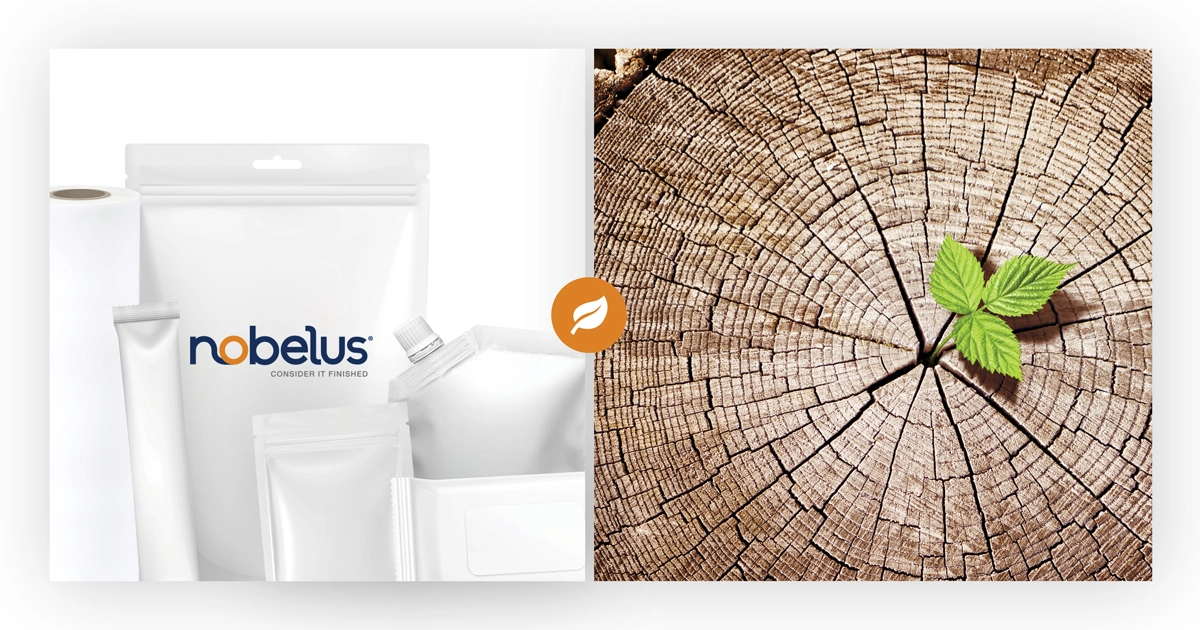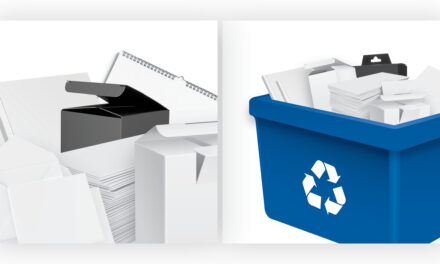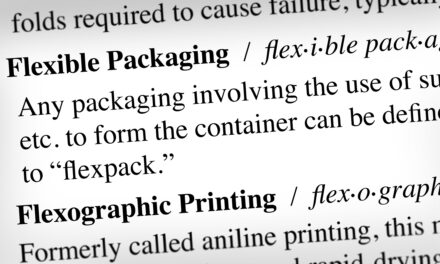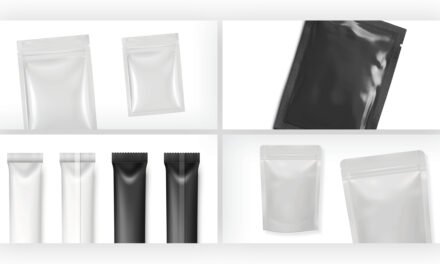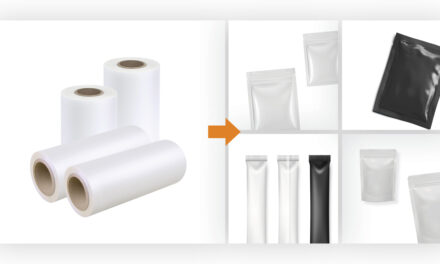A PRESSING NEED FOR SUSTAINABLE PACKAGING SOLUTIONS
Sustainability has become a growing concern for all sorts of industries, and the print and packaging industry is no exception. As environmental regulations grow stricter and brands and consumers demand more sustainable packaging, flexible packaging converters are in a perfect position to participate in the development of eco-conscious packaging and processes.
Flexible packaging, which currently makes up 19% of the packaging market with rapid growth, is already ahead of the game in many ways. According to speakers at a Global Pouch Form panel in 2011, on average, one truckload of flat flexible packaging is equal to between 10 and 25 truckloads of empty rigid packaging. By its very nature, flexible packaging is typically thinner, more lightweight, and more suitable for the lifestyles of modern consumers than rigid packaging.
However, there is still plenty of work to be done before the flexible packaging industry can claim it has successfully become sustainable. This article will look at the current state of sustainability in the flex pack industry, investigate some popular solutions, and outline the key challenges that make sustainability such a complicated subject for the average converter.
WHAT DOES SUSTAINABLE FLEXIBLE PACKAGING LOOK LIKE?
Sustainability means different things to different people, and in truth, there is no single definition or correct way to be sustainable. The word “sustainable” describes the ability to continue functioning in a specific state for an extended period. In modern times, the word has taken up a more nuanced meaning with a focus on the ways human actions and industry affect the natural world.
Sustainable practices are those that can be implemented and relied on for decades to come without inflicting unnecessary harm on the environment or at-risk people groups. Let’s take a look at a few key terms associated with sustainable flexible packaging.
Emissions include any greenhouse gases, primarily carbon dioxide, that are produced in the manufacturing and transport of the packaging. When these gases are released into the atmosphere, they trap heat and cause the planet’s temperature to increase. To calculate a product’s carbon footprint, everything from the energy used to extract natural resources to the fuel needed to move structures from facility to facility must be taken into account.
Recyclable flexible packaging can be used to create or help create new products after it is used by the consumer. Materials must be delivered to a recycling center that is able to process it, which means consumer education and participation play a vital role in making recyclable flexible packaging a success.
Compostable flexible packaging is able to break down into organic matter when placed in the correct environmental conditions. Unlike structures that are merely biodegradable, compostable packaging can break down at a similar pace to other organic materials in the compost. A package may be home compostable, or it may require specialized, heavily monitored conditions via industrial composting.
Waste includes everything from film left over after a web is slit to food products that go bad due to a faulty package. Flexible packaging that is not recyclable or compostable is considered waste material as it must be disposed of in a landfill, where it serves no further use and can take anywhere from decades to centuries to decompose depending on its construction.
Let’s also look at a couple of general concepts that can greatly impact the success of any flex pack sustainability initiative.
Accessibility: Are there pre-existing systems in place that would enable consumers, brands, and other actors in the supply chain to cooperate with the flexible packaging converter’s sustainability goals? For instance, does the target market for artisan chips in an industrial compostable bag have access to facilities that can process said bag?
Education: On a similar note, have the target consumers been educated about the options available to them? Unless people have access to such information and understand why they should care about these topics, even well thought out solutions will not be successful.
Practicality: Does the sustainable flexible package still fulfill its purpose? A converter can create excellent, environmentally friendly packaging, but if the price is too steep for brands or consumers, the solution will likely never be implemented. Sustainable packaging must balance eco-consciousness with competitive performance and pricing to see use in day-to-day life for the average person.
Legality: Governing bodies across the globe are consistently updating legislation and regulations in an attempt to counteract negative impact to the planet. Flex pack converters and brands alike would do well to stay educated on these laws and guidelines to make sure they are in compliance.
WHAT ARE SOME POPULAR SOLUTIONS AND THEIR CHALLENGES?
Now that we have covered some key concepts, let’s look at solutions that are already being pursued by flexible packaging converters as well as their pros and cons. Most people have heard the memorable phrase, “reduce, reuse, recycle,” but it can be easy to skip the first (and most important) step. The following solutions are chiefly focused on the concept of reduction, although some employ the concepts of reusing and recycling, as well.
Reduce the Amount of Plastic in the Package
Perhaps the simplest (and most cost-effective) solution, down-gauging is the process of replacing the materials in a flexible package with thinner alternatives to make a lighter package with less plastic. Down-gauging is a popular practical option for many converters as the lower cost of the package returns dividends to both the converter and their brands. It can also help reduce emissions by producing a higher product-to-package ratio, which means less fuel and space are needed to ship the finished product.
Challenges: Down-gauging is a viable solution only in situations where the integrity and performance of the package is not negatively affected. If a package breaks before it is opened or fails to protect the product inside, it will ultimately prove to be much more wasteful than a thicker package would have been. Especially in markets that focus on edible products, the quality of the package always comes first, and down-gauged packaging must be able to meet the same quality standards as thicker alternatives.
Reduce the Carbon Footprint of Flexible Packaging
Converters can make several small adjustments to their processes and sourcing that add up to significant reductions in the amount of greenhouse gases they produce. Choosing domestic suppliers (and ensuring their suppliers are also domestic) helps minimize the amount of energy and fuel required to move materials from facility to facility. Converters can implement sustainable practices within their own facilities, such as using LED lights or getting a percentage of their electricity from solar panels. Even developing ways to optimize the use of space when packing up finished products can reduce emissions by requiring fewer shipments.
It is also vital that flex pack converters select materials that will help them meet their emission goals. While metal and paper have their own distinct environmental advantages, they typically have a much higher carbon footprint than plastics, which can be produced in huge quantities for relatively little energy expenditure. Thin plastics like polypropylene (OPP) and polyethylene (PE) tend to have a smaller carbon footprint than nylon or polyester (PET) options. Many bio-based materials actually require more energy to produce than synthetic plastics.
Challenges: In our increasingly globalized economy, it can be difficult if not outright impossible to work primarily with domestic suppliers. Additionally, the solutions that produce the least amount of greenhouse gases are typically those that create the most post-consumer waste.
According to the United Nations Environment Program (UNEP), a paper grocery bag must be reused between 4 to 8 times to have a lower climate footprint than a single plastic grocery bag. As most flexible packaging, such as candy bar wrappers, chip bags, and over wraps on fresh products, is designed to be used once and then disposed of, it can be difficult to find solutions that have a lower carbon footprint without also resulting in more plastic in landfills.
Reduce the Amount of Packaging That Is Thrown Away
Speaking of landfills, 95% of the plastic products Americans threw away in 2021 ended up in landfills or the surrounding environment, which includes oceans, rivers, and green spaces near civilization. As flexible packaging continues to take over more of the packaging market, flex pack converters will be able to have a larger impact on how plastics are handled and disposed of after they serve their purpose. Preventing flexible packaging from simply being thrown away as refuse could result in cleaner waterways and less pollution in general.
Three of the most popular solutions already in action include recyclable packaging, compostable packaging, and packaging that can be used repeatedly.
Creating recyclable flexible packaging continues to be a struggle because recycling facilities do not currently have the ability to separate several different material layers in a single flex pack structure. However, mono-material structures have begun to gain wider acceptance in recycling streams, typically through store drop-off bins for grocery bags, bread bags, and similar single-material structures. Some converters also utilize film made from recycled materials as a component in their packaging.
Compostable flexible packaging may be more achievable for most flex pack converters as some (but certainly not all) municipalities currently have composting systems capable of accepting both home and industrial compostable packaging. To make compostable packaging, the converter must ensure every layer in the package from the seal layer to the adhesive is certified to break down into organic matter within a set time frame.
Some brands are utilizing reusable packaging by offering consumers a single multi-use rigid package that can be refilled with lower-emission flexible packaging replacements through a subscription. For example, instead of receiving a new rigid shampoo bottle with every order, the consumer may receive one glass bottle with a pump and refill the bottle with product shipped in large, spouted pouches. While the spouted pouch refills qualify as waste as they will go to a landfill, they do help reduce emissions by being lighter to ship than replacement rigid bottles and take up less space in the landfill when thrown away.
Challenges: Many people lack access to systems and resources that would allow them to properly dispose of packaging. Recycling pickup and material drop-off centers are not available to all consumers, and even compostable packaging will find its way to the landfill if the consumer cannot home compost or send it to an industrial composter.
Additionally, many of these processes, such as creating compostable films, can have a significant impact on the carbon footprint of a product. Converters should take care to research the true cost of their eco-friendly solutions.
HOW CAN YOU HELP RIGHT NOW?
Looking at all the challenges that accompany sustainable flex pack solutions, it can be easy to get discouraged. However, even if a single flex pack converter cannot immediately implement the solutions covered above, there are still ways for every converter to play a role in making the industry more sustainable.
Reduce Food Waste
Food waste can be considered an even bigger concern than packaging waste. The process of growing, harvesting, and transporting food products has a much higher carbon footprint than producing flexible packaging, and food waste accounts for 21.6% of the average landfill compared to an upper estimate of 13.2% for all plastic waste, not just flex pack.
30-40% of the food supply in the U.S.A. ends up being tossed away before it is consumed, and 60% of this food ends up in the landfill. Once food products are dropped into a landfill, they begin to rot and produce methane, a greenhouse gas that contributes to climate change (in contrast to composted food waste, which is able to break down into a safer and more useful form).
It may seem like flexible packaging converters have limited control over this issue; there is little a converter can do about grocery stores tossing loose produce or consumers throwing away uneaten leftovers. However, flexible packaging converters can help reduce the likelihood of food being wasted by producing superior packaging solutions that greatly extend a product’s shelf life.
Flexible packaging that has undergone diligent quality testing and application engineering gives consumers more time to eat the products they have purchased, reducing how much food is wasted. While this is not a cure-all solution, it is an excellent conversation for converters to have with brands who might be tempted to sacrifice a quality package in order to have an eco-label assigned to their product.
Improved Communication
An increase in communication between brands, flex pack converters, and suppliers is one of the most effective (and least expensive) ways to create sustainable change. Flexible packaging converters can gather information from vendors about all their material options, processes, resources, and sustainability goals to find eco-conscious solutions that work for both parties. Ask brands about what properties and characteristics they prioritize most and find out who their target consumers are to learn more about what resources they have access to.
A COMPLEX ISSUE WITH MANY PATHS FORWARD
No one solution will be able to address every problem. Ultimately, true progress in sustainability will require that people across different industries and stages in the supply chain come together for more holistic solutions. Until that goal becomes a reality, flexible packaging converters should do the best they can within their limitations.
Taking responsibility for things they can directly control, making every effort to research new technologies, and accurately communicating with vendors and brands alike will enable even a smaller flex pack converter to become more than a supplier and function as a force for environmental change.
CURIOUS ABOUT SUSTAINABLE SOLUTIONS?
As a supplier of adhesive-free films and thermal laminates, Nobelus has committed to researching and developing more sustainable print web solutions for the flexible packaging industry. If you are interested in discussing how Nobelus solutions might help you reach your sustainability goals, don’t hesitate to reach out by phone or email for in-depth consultation.

